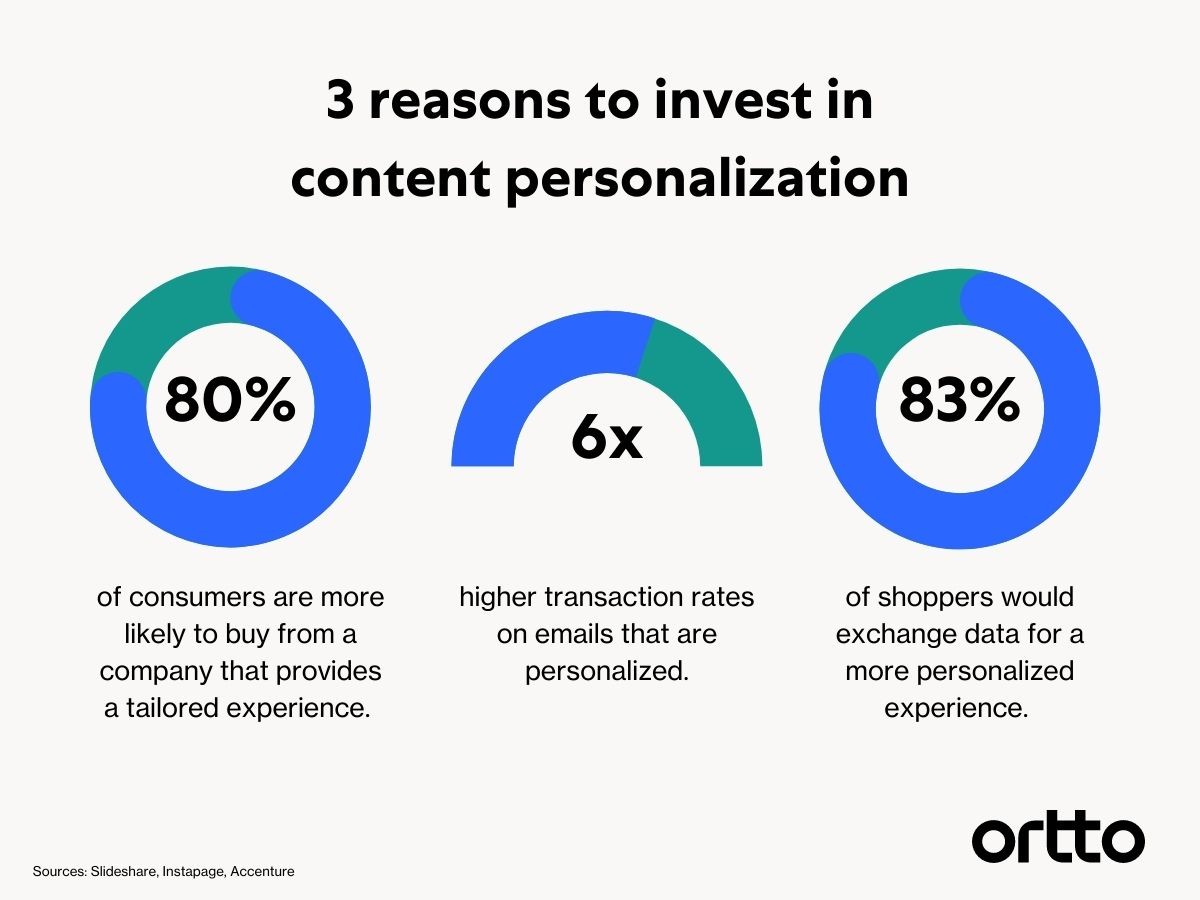Content personalization is no longer a nice-to-have for businesses looking to deliver a remarkable experience to their audience, it’s a need-to-have. After all, 72% of customers say they will only engage with personalized messaging and 63% of consumers say they won’t buy from brands that have poor personalization.
In the past, the work involved in customizing emails based on variables such as user behavior, engagement, or demographic data was relegated to technically savvy enterprise organizations using marketing software integrated with CRM and big data technology.
Today, it’s a different story. Businesses with smaller teams, less technically skilled staff, and more modest budgets can easily personalize content using first-party customer data right from within their marketing automation platform.
In this article, we’ll share three easily achievable ways to personalize email content and deliver a great experience to your audience.
What kind of data is used to personalize email content?
Email personalization takes data from known and anonymous visitors to deliver content that is relevant to the individual’s interests and motivations. The best examples of personalization couple behavioral data with demographic or firmographic information to send customers highly relevant messages at the right time.
Some data points include:
Website activity like pages visited
Interactions with marketing campaigns like emails and SMS
In-app activity including feature usage
Industry or role at company (B2B)
Visitor frequency
Purchase history or subscription plan information
Referring URL
Appointments or bookings made
In-office or in-store visits

Three achievable ways to personalize email content
These three strategies for personalizing email content can be come together in one campaign, or be used separately. As you're building campaigns, keep relevance and responsiveness top of mind — you want to respond to audience behaviors and actions with relevant content. It's as simple (and as difficult) as that.
Segmentation
Segmentation is the most popular form of personalization, in part because it is the easiest to automate and reliably execute. The complexity of your segments can range from the very basic — segmenting by industry or location for example — to the very sophisticated — using a combination of behavioral, demographic, firmographic, and financial data to build highly-specific segments.
Wherever you are on the spectrum, segmenting your audience is a worthwhile effort that can be achieved relatively easily and quickly. This is especially important when you are responding to global events or trends, so if your marketing automation platform prevents you from quickly finding the audience you need, it might be time to make a switch.
In one example of quick-thinking segmentation at work, TAXIBOX, a mobile storage provider, uses Ortto to cut through different data types and create hyper-specific segments. When Melbourne went into lockdown during the global pandemic, they were able to find audience members who lived in Melbourne and had created a quote for an interstate move, viewed the interstate moving page as a known contact, or started and not completed a booking that was an interstate move in the past 30 days. This segment received an email confirming that TAXIBOX was still operating through lockdown, and could handle a contactless interstate move.
Merge tags and liquid language
There are a number of ways to add dynamic content sections to your emails. This will mean the content is updated in real time based on the customer data you have and any rules you apply.
The simplest example of this is merge tags adding an individual's first name as a greeting or a specific lead owner's name showing as a sign-off. Merge tags can be applied quickly and easily in most marketing automation platforms, and many businesses will use a combination of data types in merge tags throughout a longer email. The
A more advanced version of this is liquid language. Liquid is an open-source template language created by Shopify. It does require some technical understanding, it is written like HTML markup, but basic applications are easy to achieve when you reference help documentation. The great thing about liquid is, once you get the hang of it, you can easily automate deep personalization tactics in emails that use real-time data.
If this granular level of personalization is intimidating, start small with a few customer details in a high-volume email and grow from there.
Behavioral triggers
Personalizing content is as much about the right time as it is the right content and, more often than not, the right time is not 'Monday at 8am,' it's 'when your brand is top of mind' or 'when your customer needs an answer to a question.'
No one's expecting you to read minds, but you can read behavioral data. Activities like website pages visited, product features used, support tickets logged, or time elapsed since last appointment or booking can be used to trigger messages in automated email journeys.
For example, if a new lead visits your pricing page, it's a great time for your sales team to reach out. If it's been a year since a patient's last checkup, it's time to remind them to book an appointment.
Behavioral triggers help with the responsiveness part of your personalization strategy, to master relevance you will need to ensure the message you send is connected to the behavior they took. For example, if a prospect was exploring an article about reaching savings goals, they're unlikely to be interested in content or product recommendations about credit cards and loads.
Three steps to successful email personalization
If you're not currently personalizing your emails, or you want to improve your personalization strategy, start by following these four steps:
1. Unify your data
Customer data is typically housed in several platforms and data silos including your website, app, CRM (for example, Salesforce), hosted landing pages, and customer service software. The best examples of personalization use combinations of data to segment, build dynamic content sections, and add behavioral triggers.
The first step is to unify your data to build a single customer profile. A customer data platform (CDP) is the perfect tool for the job.
“Setting up a centralized customer-data platform (CDP) to unify paid and owned data from across channels is essential to [personalization] efforts. Unlike traditional CRM solutions, CDPs provide built-in machine-learning automation that can cleanse internal and external data, connect a single customer across devices, cookies, and ad networks, and enable real-time campaign execution across touchpoints and channels. The best ones are also easy to use.”
—McKinsey, 2019
Next, you want to ensure all that data in your CDP is readily available in your marketing automation platform and can be easily filtered or found by marketers themselves. This is more important now than ever before — there is a need for markers to act quickly and respond to real-world events (on a macro and micro scale). If they need to loop in another team and wait for data before they can schedule an email, they're being held back.
2. Build customer segments
Now that your data is unified and enriched, you can start to build audience segments based on specific attributes, interests, website activities, and purchases or subscription information. These audiences should be dynamically maintained to ensure relevancy in the moment.
You'll likely want to build more audiences as your personalization efforts become more sophisticated, or to use filters to build specific entry criteria per campaign. However having a number of reliable go-to audiences will help speed up your output.
Some examples of helpful segments include engaged customers, engaged prospects, slipping customers, and segments based on plan or subscription tier.
3. Follow content personalization best practice
There are a few best practices that should be adhered to whenever you use personalization strategies in your email content.
Protect customer privacy: while the need for customer data is real, it should never outweigh the need to protect your customer’s privacy. Ensure your company is following GDPR and other data privacy laws and limit the processing of personal data to what is necessary, protect against theft, and grant customers the right to remove their data.
Personal, not invasive: be careful about the data you use and the balance of data. Customers like to receive relevant emails, they do not like to feel as though you know everything about them and their family. Re-examine your campaigns in the customer's seat, and pull it back if you feel the content is overly personal.
Actions speak louder than words: There's not that much you can really tell about a person based on a singular demographic data point. Behavioral data, however, tells you what the individual is thinking about, their goals, and their questions or concerns — personalizing with at least some behavioral triggers or activity-based dynamic fields will go a long way to delivering a great experience.
The final word
Personalization is just getting started. Predictive analytics, AI-created content, and improved algorithms will give marketers new opportunities to send their audience highly relevant and responsive messages at scale.
It's exciting stuff, but if you're not there yet, don't feel overwhelmed by a promise for the future. Use the data you have, build a martech stack that puts personalization in the marketer's hands, and just get started.



